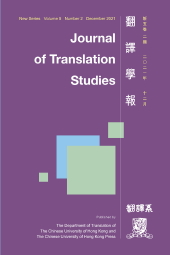 |
|
|||||||||||||||||||||||||||||||||||||||||||||||||||||||||||||||||||||||||||||||||||||||
| 「耶」「佛」之間的碰撞與融合:李提摩太《大乘起信論》英譯研究 |
|---|
| 楊靖 (Jing Yang) 中國 江西師範大學外國語學院 |
|
摘 要 1894年,英國浸禮會傳教士李提摩太英譯了真諦漢譯本《大乘起信論》,並於1907年由上海廣學會出版。此譯本是繼日本學者鈴木大拙出版的譯本以來的第二個全譯本,卻沒能引起學界的足夠重視。本文基於一手史料,分析了此論的作者、整體內容以及核心概念「真如」在李氏的神學思想體系裡通過其英譯本如何再次重構與呈現。本研究的發現如下:李氏受到英國傳教士比爾「偽基督論」的啟示,從此論構建出世界宗教聯合後所獲得的「正義」,而這種正義正是上帝國的主要特徵,也是上帝國得以建立的前提。為充分證明並散播此構想,他通過譯本將原文的「真如」概念以上帝之名義重構,為讀者呈現解讀後不同於鈴木的全新譯本,為其建立上帝國的抱負作了思想準備。 Abstract Timothy Richard, a missionary of Baptists, translated Zhen Di’s Chinese translation sutra Da Chen Qi Xin Lun into English in 1894 and this version was published in 1907 by the Christian Literature Society. Following the first version by Suzuki, this full version elicited little attention. This paper, based on primary historical files, discusses how the book’s author, its content and the concept Zhen Ru were reconstructed under Ricard’s Theology. It discovers that, inspired by Beal’s Pseudo-Christian interpretation, Richard found Righteousness in the union of world religions from this book. This Righteousness is essentially what is needed in the building of the Kingdom of God. In his translation, he reconstructed Zhen Ru in the name of God and brought a totally new book to readers. His translation is the preparation for the building of the incoming Kingdom of God. |
| 文學眼光:李思達(Alfred Lister, 1842–1890)及其中國文學翻譯 |
|---|
| 季凌婕 (Lingjie Ji) 中國香港 香港中文大學 |
|
摘 要 十九世紀中國文學作品英譯史的現有研究中,學界對幾位知名漢學家的探討頗為豐富,可是應當注意到,包括文學翻譯在內的十九世紀英國漢學的發展同樣離不開大量在華西人的積極參與,其中許多人的貢獻仍未得到足夠關注。本文的研究對象李思達(Alfred Lister,1842–1890)就是這樣一位還不為人所知的譯者,他於1865年以香港翻譯官學生身份來到香港,在殖民地政府中歷任多職,曾擔任驛務司(Postmaster General)和庫務司( Treasurer)等重要職位。自從來港學習中文開始,李思達便關注中國知識,在不同漢學期刊發表多篇中國研究文章及翻譯作品,尤其傾心於中國文學的翻譯。本文通過發掘史料及文本考析,梳理李思達翻譯中國文學作品的選材、觀念及方法,結合他的殖民地經驗及當時中國研究語境,探討文學翻譯實踐如何發生及展開,其中又展現了怎樣的文學眼光,為我們理解十九世紀中國文學英譯史帶來新的發現。 Abstract Much has been written about the prominent British sinologists in the history of English translations of Chinese literature in the nineteenth century. It should be noted that the development of British sinology, including literary translation, in the nineteenth century was also marked by the active participation of a large number of foreign residents in China. Their contributions have not yet received sufficient attention. This paper examines the life and work of Alfred Lister (1842–1890) as a translator of Chinese literature who is still largely unnoticed. Since his arrival in Hong Kong in 1865, Lister had served in several offices in the colonial government, including Postmaster General and Treasurer. He had published actively in contemporary sinological journals, with a particular interest in translating Chinese literary works into English. With archival research and textual analysis, this paper examines his selection of source texts and his concepts and translation methods. It explores how the practice of literary translation had developed in the context of his colonial experience and the Chinese research environment in Hong Kong at the time. This paper brings new perspectives to our understanding of the history of English translations of Chinese literature in the nineteenth century. |
| From a Gods and Spirits Story to Socialist Realist Children’s Literature: The Wizard of Oz in China (1920s–1970s) |
|---|
| Qilin Cao University of Macau Macau, China |
|
Abstract This article intends to investigate how The Wizard of Oz was introduced, translated, and retranslated in China from the 1920s to the 1970s. Inspired by the historical archives mostly from Shenbao 申報, this paper firstly delineates the early acceptance of the Oz story by revealing how it was introduced, synopsized, and advertised in China between the 1920s and the 1940s. In this part, the novel’s early translation versions are investigated, with a particular focus on its title translation—“Lüye xianzong 綠野仙蹤,” to illustrate an initial acceptance of the novel as a story about gods and spirits. In the second part, as the sociopolitical context underwent major changes after the establishment of the People’s Republic of China, the translation of the novel was required to conform to the prevailing socialist realist tenets, and the novel was reinterpreted, retranslated, and reshaped as a piece of socialist realist children’s literature. This part concentrates on a comparative reading of Chen Bochui’s 陳伯吹 three translations (published sequentially in 1942–1943, 1953, and 1979). In investigating the translation history of The Wizard of Oz in China in the given period, this study suggests the nature of (re)translation as a complex process with multiple mediating forces. |
| The Cognitive Turn in Metaphor Translation Studies: A Critical Overview |
|---|
| Wenjie Hong Université Grenoble Alpes France |
| Caroline Rossi Université Grenoble Alpes France |
|
Abstract Metaphor translation has been a matter of concern in translation studies because its interlinguistic transfer can be impeded by cross-cultural and crosslinguistic differences. Since the inception of Conceptual Metaphor Theory (CMT), which focuses on the conceptual structure of metaphorical language, a range of studies have emerged to investigate metaphor translation from a cognitive perspective, presenting an eclectic mix of research questions and methodologies. This paper is targeted at illustrating what the cognitive approach has offered to translation studies by providing a critical overview of recent research in metaphor translation from a cognitive perspective. It is pointed out that cognitive theory can get to the heart of metaphor, an essential cognitive device for meaning-making, as well as translation, a cognitive activity. Illustrations from the literature show that a cognitive approach can account for in-depth conceptual transfer in the analysis of product- and process-oriented metaphor translation. The cognitive approach also provides important insights into translation as crosscultural communication by offering a redefinition of culture. Within this context, the paper provides multilingual illustrations while paying special attention to translation between culturally-distant languages, e.g., English-Chinese and French-Chinese translation. Lastly, it is argued that there is potential in combining cognitive theory with translation theories such as Descriptive Translation Studies and the Interpretive Theory of Translation. |



